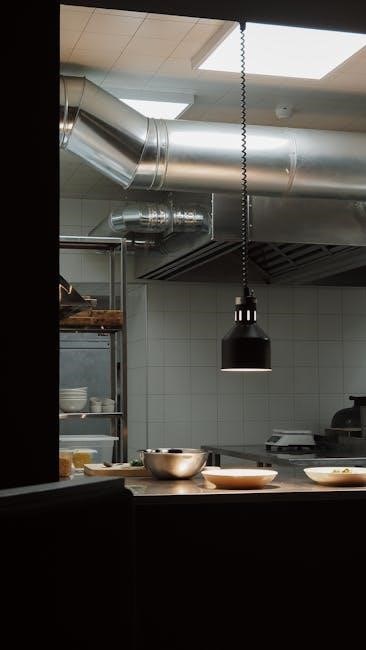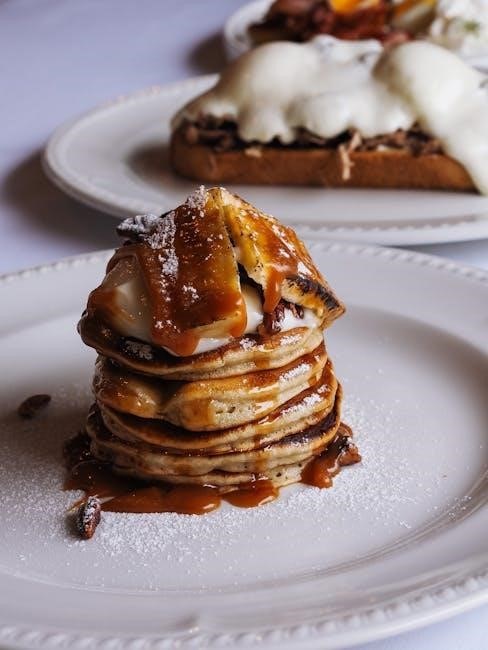Soda transforms cooking, adding fizz and flavor to a variety of dishes, from baked goods to marinades, making it a must-try ingredient.
1.1 Baking Soda as a Key Ingredient
Baking soda, or sodium bicarbonate, is a fundamental ingredient in cooking and baking, known for its ability to act as a leavening agent. It releases carbon dioxide gas when combined with an acid and heat, causing dough or batter to rise. Beyond baking, baking soda is versatile: it tenderizes meat, enhances browning, and speeds up cooking processes. For example, adding it to marinades can break down proteins, making meat more tender. It’s also a natural cleaner and odor neutralizer, often used in fridge storage. When used correctly, baking soda elevates dishes, but it’s crucial to measure it precisely to avoid a soapy taste. Its chemical properties make it indispensable in both sweet and savory recipes, from classic Irish soda bread to crispy fried foods. Understanding its functions is key to unlocking its culinary potential.

1.2 Exploring Other Sodas in Cooking
Beyond baking soda, various flavored sodas like cola, root beer, and cream soda are being creatively incorporated into recipes. These carbonated beverages add unique flavors and moisture to dishes, enhancing both sweet and savory creations. For instance, cola can glaze ham or marinate ribs, while root beer pairs well with desserts like cakes. Cream soda is ideal for light, fluffy waffles or sweet treats. Even craft sodas with unique flavors are being used to craft distinctive dishes. Experimenting with different sodas allows chefs to infuse beverages directly into their cooking, creating bold and refreshing culinary experiences. This trend showcases the versatility of sodas beyond their traditional role as drinks, making them a fun and innovative addition to modern recipes.

The Science of Soda in Cooking
The science behind soda in cooking lies in its chemical reactions. Baking soda, or sodium bicarbonate, reacts with acids to release carbon dioxide, causing dough to rise. It also neutralizes acidity, enhancing flavors and tenderizing ingredients like meat. This dual action makes soda a versatile and essential element in both baking and savory dishes. By understanding its properties, chefs can harness its power to create lighter textures and richer tastes. Soda’s chemical properties are fundamental to achieving desired culinary outcomes.
2.1 Chemical Properties of Baking Soda
Baking soda, chemically known as sodium bicarbonate (NaHCO3), is a white, crystalline powder with a slightly salty, soapy taste. Its primary role in cooking stems from its ability to react with acidic ingredients, releasing carbon dioxide gas. This reaction not only leaven baked goods but also neutralizes acidity, balancing flavors. When exposed to heat, baking soda decomposes into sodium carbonate, water, and carbon dioxide, further enhancing its leavening properties. Its alkaline nature makes it effective in tenderizing meats and enhancing browning. Proper measurement is crucial, as excess baking soda can leave a bitter aftertaste. Understanding its chemical behavior ensures optimal use in recipes, making it a versatile and indispensable ingredient in both sweet and savory dishes.
2.2 Role of Carbonated Drinks in Recipes
Carbonated drinks bring a unique dimension to cooking, offering both flavor and moisture to dishes. Sodas like cola, ginger ale, and cream soda are versatile, enhancing marinades, braising liquids, and baked goods. They add a sweet, tangy flavor and help tenderize meats. For instance, cola-based marinades for ribs create a rich, caramelized glaze, while ginger ale can add a subtle spice to baked ham. In desserts, sodas like Mountain Dew create vibrant, citrusy cupcakes. The carbonation also helps create light, airy textures in treats like Sprite biscuits. Experimenting with different sodas allows chefs to craft distinctive dishes, making carbonated beverages a fun and innovative addition to both sweet and savory recipes. Their versatility ensures they remain a valuable ingredient in modern cooking.
Tips and Tricks for Using Soda
Store baking soda separately to maintain potency, measure accurately for recipes, and pair it with acidic ingredients like buttermilk for optimal results in cooking and baking.
3.1 Measuring and Using Baking Soda Correctly

Accurate measurement is crucial when using baking soda, as excess can leave a soapy taste. Store it separately from refrigerator baking soda to maintain potency. Always sift or stir well before measuring to ensure even distribution. Use a teaspoon or digital scale for precise amounts. Baking soda reacts with acidic ingredients like buttermilk or yogurt, so pair it correctly for optimal results.Avoid overusing, as too much can disrupt flavor. For marinades or tenderizing meat, mix 1-2 tablespoons per pound of meat. When substituting in recipes, use 1/4 teaspoon baking soda for every 1 cup of acidic liquid. Proper usage enhances texture and flavor, making it a versatile tool in your culinary arsenal.
3.2 Pairing Soda with Other Ingredients
Pairing soda with complementary ingredients enhances flavor and texture in dishes. Dark sodas like cola or root beer work well in marinades, adding depth to meats, while cream soda pairs beautifully with vanilla or caramel. For sweet recipes, combine soda with citrus or berries for a refreshing twist. In savory dishes, mix soda with spices or herbs to create balanced flavors. Acidic sodas like ginger ale complement tomatoes in sauces or braising liquids. Experiment with small batches to find harmonious combinations, ensuring flavors don’t clash. This creative approach elevates both sweet and savory creations, making soda a versatile partner in your culinary journey.

Popular Soda-Based Recipes
Discover beloved dishes like Cola-Glazed Ham, Dr. Pepper Ribs, and Mountain Dew Cupcakes, showcasing soda’s versatility in both sweet and savory culinary creations.
4.1 Savory Dishes with Soda
Soda adds a unique twist to savory recipes, enhancing flavors and textures. Cola-Glazed Ham is a standout, with its sweet and sticky finish. Dr. Pepper Ribs are tender and caramelized, while Shrimp in Cola-Chipotle Sauce offers a smoky kick. Ginger Ale Baked Ham provides a refreshing twist, balancing tangy and sweet notes. These dishes showcase soda’s ability to elevate savory meals, adding depth and complexity. Experimenting with different sodas can transform ordinary recipes into extraordinary ones, making soda a versatile ingredient in your kitchen.
4.2 Sweet Treats Using Soda

Soda infuses sweetness and effervescence into desserts, creating unique and delightful treats. Mountain Dew Cupcakes are a vibrant example, with their bright color and citrusy zing. The 7UP Pound Cake offers a moist texture and subtle lemon flavor, while Coca-Cola Cake delivers a rich, chocolatey taste. These recipes showcase soda’s ability to enhance sweetness and add a refreshing twist to traditional desserts. Whether you’re making light and fluffy waffles or coconut-infused desserts, soda adds a surprising dimension to sweet dishes, making them stand out. Experiment with different sodas to discover new flavors and textures, perfect for impressing friends and family with creative treats.
Mastering soda in cooking unlocks creativity and enhances flavors. From savory dishes to sweet treats, soda adds a unique twist, making it a versatile ingredient for culinary experimentation.
5.1 Advanced Techniques and Experimentation
Experimenting with soda in cooking opens up a world of creative possibilities. Advanced techniques involve using soda as a marinade, a brine, or even as a base for sauces. For instance, cola can tenderize meats, while ginger ale can add a subtle sweetness to baked goods. Fermentation is another area to explore, where soda can be used to create unique, fizzy beverages with probiotic benefits. Craft sodas, infused with herbs and spices, offer a personalized touch to cocktails and mocktails. Pairing soda with unexpected ingredients, like citrus or spices, can elevate both savory and sweet dishes. These techniques not only enhance flavors but also showcase soda’s versatility beyond traditional recipes, making it a exciting ingredient for culinary innovation.
5.2 The Future of Soda in Cooking
The future of soda in cooking is poised for innovation, with chefs and home cooks increasingly experimenting with its versatility. As sustainability gains importance, soda’s role in reducing food waste and enhancing flavors will grow. Fermentation techniques using natural sodas are expected to rise, offering health benefits like probiotics. Craft sodas, with unique flavors, will inspire new recipes, from marinades to desserts. The trend of using soda as a base for sauces and dressings will expand, while its use in sous vide and molecular gastronomy will become more refined. With creativity and science, soda will continue to evolve as a dynamic ingredient, pushing culinary boundaries and redefining its role in modern cuisine.